Rise of the robots continues in livestock sector
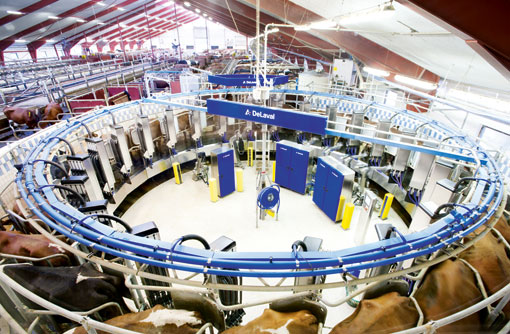
Robots are being used on UK farms in increasing numbers for an ever wider number of tasks. Andy Collings reports.
Only 20 years ago, robots still conjured up an image of uncomplaining humanoid machines performing repetitive tasks while their owners sipped Pimms beside a sun-soaked swimming pool.
If you ignore the humanoid element (and, sadly, the Pimms and the swimming pool), this description is now not that far off the mark.
It is eliminating the repetitive element of these often-mundane jobs that has been the spur for much of the robot development. In agriculture this has led to the development of robots to milk and feed cows, scrape slurry, load pallets, pressure wash pig buildings and precision hoe vegetable crops.
The bottom line in all cases is whether or not the use of a robot is more economical than paying wages for someone else to do it. But while this is a key factor, many would maintain it is not the only consideration.
In many situations, robots do a better and more consistent job than their human counterparts and can continue to do it without hint of complaint for as long is required.
ROBOTIC MILKING MACHINES
Since their introduction to the UK in the mid 1990s, robotic milking machines (pictured above) have gradually achieved an ever larger foothold in the dairy industry. There are now upwards of 500 robots milking cows in the UK and Northern Ireland.
Key to the system is the automation of teat-cup placement – a system that uses intricate guidance techniques combined with stored cow information. Other features include controlled cow traffic, ration feeding, teat cleaning and milk management.
Interestingly, it is now accepted that one of the restricting factors in the use of robotic milking systems is not the cows but the farmer, who often finds it more difficult to adapt to such a system than the cows.
Advantages
• Labour reduction
• Cows are free to select own milking interval
• Individual quarter milking
• Lower cow stress levels.
Disadvantages
• High initial cost
• One unit required for maximum 70 cows
• Could restrict field grazing due to distance
• Increased complexity.
FEED PUSHERS
The bane of most farmers who feed rations to cows in passageways is the need to push feed closer to the barrier several times a day so the cows can eat it.
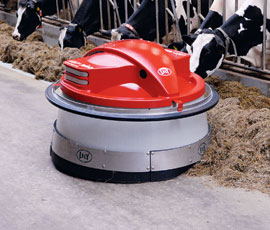 All this can be avoided by using Lely’s Juno, which works a solitary existence, roaming endless lengths of feed passages, at programmable intervals, pushing feed over to the cows.
All this can be avoided by using Lely’s Juno, which works a solitary existence, roaming endless lengths of feed passages, at programmable intervals, pushing feed over to the cows.
Introduced three years ago, the Juno 150 is driven by two wheels and supported by a third. Guidance is achieved by using an ultra-sound sensor to maintain the unit at a set distance from the feed barrier.
Feed material is shifted using the unit’s rotating skirt – a heavy concrete block within the machine provides sufficient grip and stability to ensure the feed is moved inwards, rather than the machine outwards.
The whole unit is powered from batteries and, at intervals, during its wanderings, Juno connects up with a recharger unit placed in the feed passageway.
A smaller version is due to be launched next month.
Advantages
• Cows always have access to feed – increased intake
• Cow contentment
• Cleaner feed passageways
• Automatic operation – no labour or tractor required
Disadvantages
• High initial cost
• Some passageways may not be suitable – for example, steep slopes
MUCK SCRAPERS
Robotic automation of livestock equipment also extends to machines to scrape muck clear of slatted floors. Lely’s version, the Discovery 90SW, is powered electrically from batteries, which can be automatically recharged at a docking station.
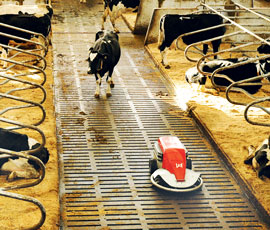 Propulsion and steering is controlled from two independently driven rear wheels, while at the front a 1m-wide rubber blade clears the slurry.
Propulsion and steering is controlled from two independently driven rear wheels, while at the front a 1m-wide rubber blade clears the slurry.
In action, the unit follows a pre-set course along slatted passageways with a freely rotating wheel of the same diameter as the width of the machine, guiding it along walls and around cows that may be standing in its way.
Setting the 90SW apart from earlier models is the use of water. This can be sprayed on to the surface of the floor to soften the manure and allow it to be scraped clear more easily.
Water – 30 litres of it, which is sufficient for one 30-minute trip – is automatically loaded into a tank when the unit is being charged.
Advantages
• Reduction in cow foot troubles
• Cleaner cows
Disadvantages
• Can only be used on slatted floors
PRESSURE WASHERS
Pressure washing is not everyone’s first choice when considering uses for robotic operations. But according to cleaning equipment specialist Nilfisk-Alto, there is a place for such automation when it comes to cleaning pig stalls – it’s that repetitive work syndrome again that lends itself so well to robotic operation.
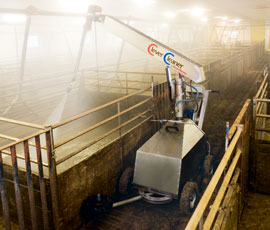 The Multicleaner 7-53 is a self-propelled machine that delivers high-pressure water from a nozzle on the end of a centrally mounted arm, which can be rotated and positioned.
The Multicleaner 7-53 is a self-propelled machine that delivers high-pressure water from a nozzle on the end of a centrally mounted arm, which can be rotated and positioned.
Both the movement of the machine and the nozzle arm can be programmed to clean a stall – a sequence of movements that are then repeated when the machine enters the next stall.
It’s not the only robotic washer. Ramsta Robotics (sold in the UK via Technijet) makes a £25,000 robotic cleaner called the Clever Cleaner. More than 400 are said to be working in Sweden.
Advantages
• Labour reduction
• Up to 80% less manual cleaning time needed
Disadvantages
• Initial cost
FEED AND PUSH
The appropriately called Butler system, built by Austrian company Wasserbauer, is an interesting machine. At programmable intervals, it sets off on a tour of the cow shed to push up feed and provide cows with an appetite-stimulating sprinkle of concentrate.
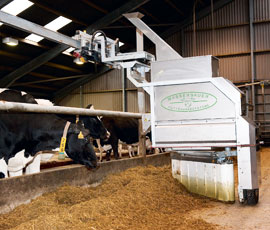 A powered conveyor belt is used to push the feed over to the cows and, at the same time, a small amount of concentrate is delivered from a hopper positioned above the belt.
A powered conveyor belt is used to push the feed over to the cows and, at the same time, a small amount of concentrate is delivered from a hopper positioned above the belt.
The whole unit is guided by an overhead rail and powered by two motors – one for the rail connection and one on the floor. Synchronised, they work to keep the conveyor belt at right angles to the barrier.
Programming allows up to 14 tours to be made each day and also to feed different amounts of concentrate if the cows are segregated into high or low yielding groups. At the end of each tour, the unit attaches itself to a charger to top up its 24-volt system and, at the same time, the concentrate hopper is refilled.
Advantages
• Higher feed intake
• Cleaner feed passages
• Reduced labour
Disadvantages
• Guide rail can be an obstruction for mixer wagons
• High initial cost
• You can see many of these machines in the flesh at next month’s Dairy Event and Livestock Show, to be held on 6 and 7 September at the NEC, Birmingham.

